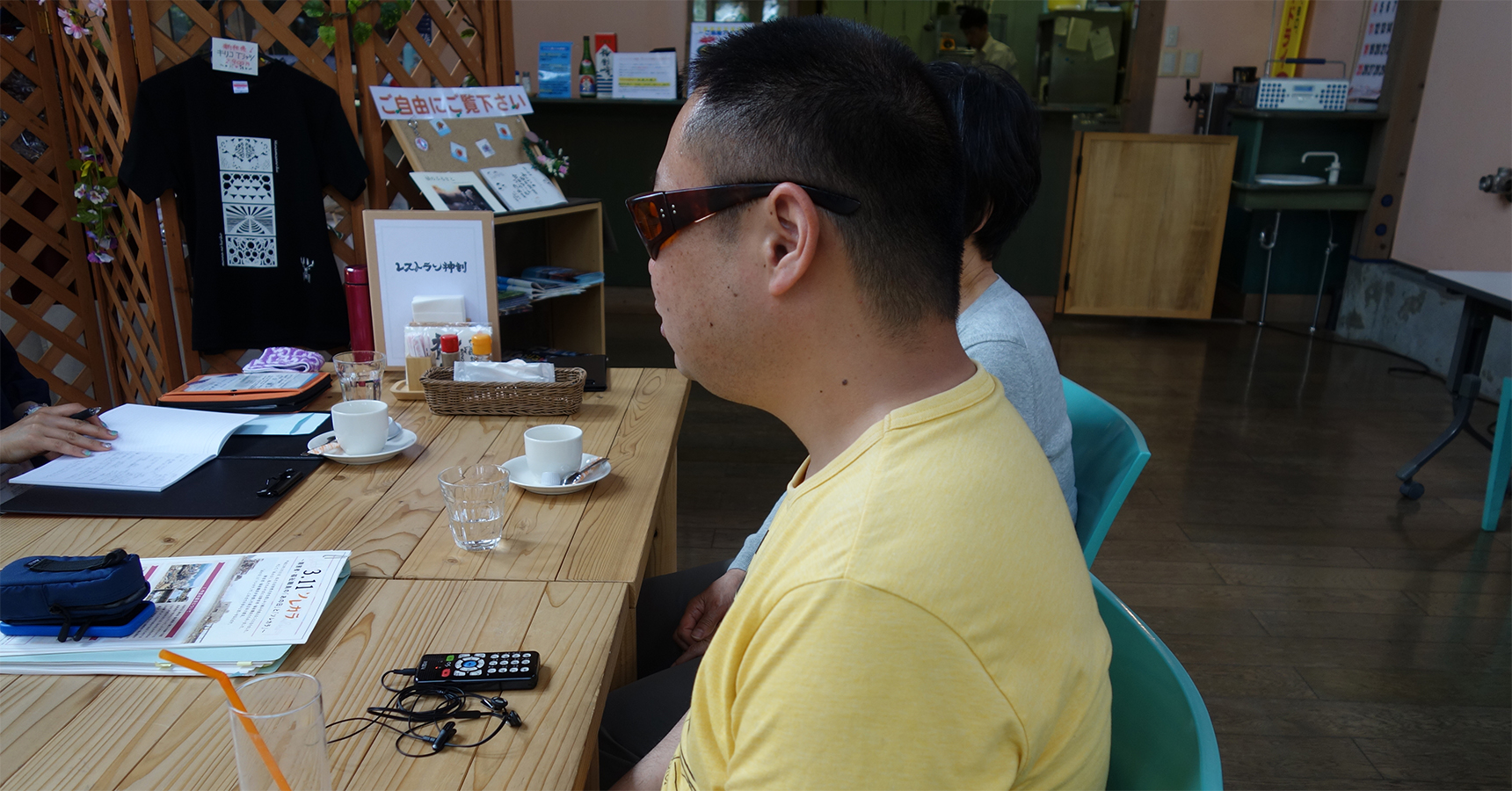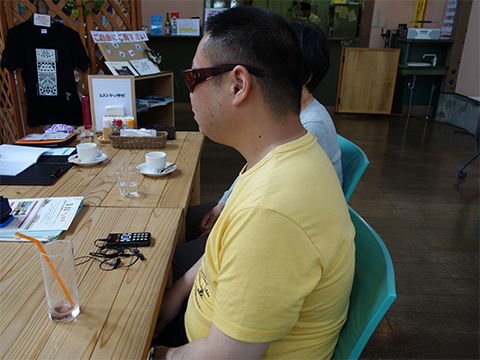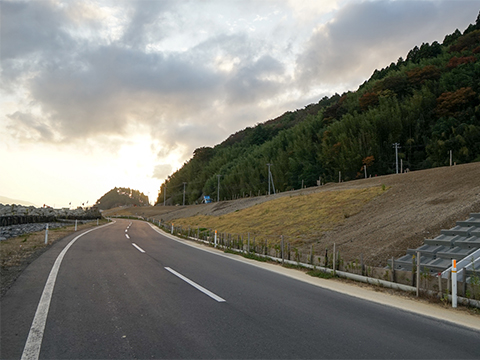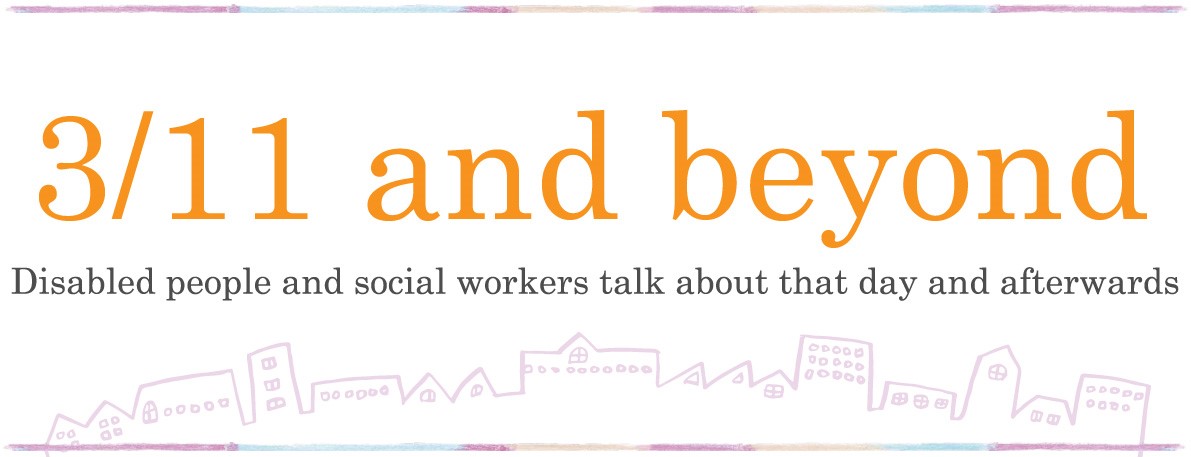 Story: Mr. Kenichi Oyama (man/ in his 30s at the time/ deaf-blind [visually and hearing impaired])
Story: Mr. Kenichi Oyama (man/ in his 30s at the time/ deaf-blind [visually and hearing impaired])Mr. Kenichi Oyama
 Story: Mr. Kenichi Oyama (man/ in his 30s at the time/ deaf-blind [visually and hearing impaired])
Story: Mr. Kenichi Oyama (man/ in his 30s at the time/ deaf-blind [visually and hearing impaired])Earthquake
Where were you at 2:46 on the day of the earthquake?
I was alone watching TV in my private room on the second floor. Then it started shaking. The shaking was really severe, so I thought it was the end of me along with the building.
So you thought it was different from a normal earthquake?
I mean, it just started shaking like crazy all at once. I was in shock. Fortunately I moved right away, and walked five steps to reach the wall near the door of my room. I stayed there for a really long time.
How did you escape from the second floor to the first floor?
It was my house, so I knew the way by touch. I could see a little better than I can now, so I was able to get out to the yard from the second floor.
Were you aware a tsunami might come when the earthquake happened?
Yes. My region is the area where the Sanriku Earthquake tsunami and the Great Chilean Earthquake tsunami struck, so I’d had evacuation drills for both earthquakes and tsunamis since elementary school. There was also an earthquake two days before, right? I’d heard that earthquake had also caused an around 1 meter tsunami that almost flipped ships over, so I was sure. My instinct told me this tsunami would be at least 5 or 6 meters. But I never thought it would be a 15 or 16 meter tsunami that would wash my house away.
I’d like to ask you about the damages. Do you mean your entire building was swept away?
The house and the shed were both completely destroyed. Only the foundations were left.
Was your family okay?
My family members were all at work and experienced the disaster in their separate workplaces, but they were all okay. That was a relief. I thought they’d all been swept away. I couldn’t get reception on my phone after the disaster, and it was a few days to a week before I was able to meet them in person and confirm they were safe. A lot of the information coming into our region was tragic, and although an acquaintance who had walked back home from far away reported seeing some of my family members, I didn’t know their exact status. I couldn’t rest at ease until I saw them face to face. I’ll never forget how that felt.
Living in the shelter
Where was the evacuation center for your region?
We’d been told that when a big earthquake came, we should start by evacuating to high ground. The people from the elementary school had also climbed up the mountain to escape from the tsunami. So there were a lot of people in the evacuation center on the mountain.
Around how many people gathered at the evacuation center?
I think there were around 200. It was completely packed. It wasn’t only people from my neighborhood, but also people from surrounding neighborhoods whose homes had been washed away. The people living in the hills were also in danger, so everyone gathered in the shelter and stayed together. Because I mean, that night it just kept on shaking.
Around how long did you stay there?
Until the end of May, so around two and a half months. It was a long time.
Did anyone besides your family and friends offer to help you at the shelter?
All kinds of people at the shelter offered to help me and got meals for me. Sometimes I would receive my meal and chat with the people nearby who had helped me. But because I can’t see or hear much, I had no idea what was going on around me and couldn’t offer to help anyone. So there were times when I wanted to do something, but couldn’t.
Problems at the shelter
Did you have any problems or troubles in this shelter full of so many people?
At that time I was just focusing on getting through each moment, so maybe I wasn’t really aware of it, but various things did happen that were stressful. The biggest problem was the toilet. I couldn’t use the toilet by myself. I couldn’t see, and I couldn’t get around on my own. Sometimes I held it from 8 in the morning until my family came back around 5 in the evening. Of course, even though I couldn’t see, eventually I did manage to find routes I could take by myself, started using the outhouse by the house near the shelter, and got used to living in the shelter and learned to go to the toilet on my own, but I think it took around a month.
Did you have any other problems?
Let’s see. It was also difficult having no private space. Always having someone looking at me. Although of course there were also people I knew there and they were taking care of me, it was just mentally exhausting. I was grateful to the people who were looking out for me, but also resented being constantly watched. So my feelings were a bit complicated. So sometimes when I went to use the outhouse by the house down the mountain, I felt this indescribable sense of liberation. It was like the outhouse was my only private space, so sometimes I went there even though I didn’t need to go.
So you needed someplace to be alone.
I’ve also heard from other visually impaired people that private space is especially important to them. When you can’t see, you don’t know what’s going on. But when you’re in a private room, you can relax. I mean, I can’t really be alone, because I need other people’s knowledge and help. That’s kind of frustrating to me. I have complicated feelings about it. Of course, people are helping me, taking care of me, and looking out for me. I’m the one receiving their help, and I’m nothing but grateful for that. But aside from that, it really is hard not having privacy. There was also one more problem I had.
What was that?
The amount of food. When the Self-Defense Force started handing out bento boxes as relief supplies, the elderly people would just try hard to eat up their portion even it was sometimes too much for them. They couldn’t throw away what they’d received in this kind of situation. Some people did force themselves to eat everything. It was a lot even for me. But I thought, I have to eat everything or it will be thrown away, and it’s easier to clean up if I eat it all anyway. After a while, I heard one old lady who was trying to eat all her food mumble, “It’s too much.” Then I realized elderly people just aren’t capable of eating that much. So I said, “Don’t worry about leaving some of it. It’s not good for you to eat it all. You’re not doing anything wrong.” Then from the next meal she started leaving some of her food. At first I think everyone felt pressured because they felt they had to be grateful for what they’d received and treat it with respect. It might seem outrageous for me to say this even though everyone was just trying to help us, but people normally have a certain amount they can eat, and when they can’t regulate the amount, it’s a problem. It something you don’t even think about in ordinary life.
When you said there was a problem with food, I thought you were going to say there wasn’t enough, that there was far too little and you had to figure out how to split it up. But it was the complete opposite. So everyone has a certain amount they’re capable of eating.
Even things we normally enjoy eating like rice balls from the convenience store or supermarket gradually become hard to get down after weeks in a shelter. That was a unique shelter experience.
In those circumstances, I remember that the normal, everyday foods like miso soup and boiled vegetables the women made with the supplies that came to the shelter were really delicious.
Living in government-paid housing

So you were in the shelter until around May. Did you move into temporary housing after that?
I moved into a vacant house that was paid for by the government as temporary housing for disaster victims. I lived there with my family, about a 20 minute drive from my hometown.
Around how long did you live there?
Until September 2016, five years and four months. The house had been built a long time ago and no one was living there, so at first I had a hard time getting used to the environment, and it was quite hard because I couldn’t move around freely inside. But it was better than prefabricated temporary housing because it provided private space for our family, and we were grateful we were able to get it because all the apartments and such were full at the time.
Did someone from the city give you the information about this house?
A friend actually introduced it to me. We knew we couldn’t stay in the shelter forever, and my family really wanted to find a place to settle down soon. So although there were a lot of inconveniences and concerns for me because of my disabilities, we decided to move into the vacant house. There were lots of other vacant houses in this region, and disaster victims did live in them for some time, but the area is surrounded by mountains and has a lot of bugs like stink bugs, ladybugs, and centipedes, so a lot of people moved into prefabricated temporary housing. The house we lived in had also been vacant for six or seven years, so even if we cleaned it there were still a lot of bugs. But even so, we were grateful to have private space for our family and be able to live together as a family.
Lifestyle changes after the disaster

How has your life changed since the disaster?
Before the disaster, I lived a normal life with my family even though I couldn’t see or hear well, but after the disaster the biggest change was that I could no longer move around my home and my neighborhood by feel like I used to, even though I couldn’t see much. Even after I left the shelter, for around a year I couldn’t get around because I was in a new environment.
After that I thought, I can’t go on like this, and searched the Internet for “visually impaired people and jobs.” At that time I could still see my phone screen. The first thing that came up was the Sendai Support Center for the Late Onset Visually Impaired. It was near the place I had lived in Sendai for four years as a student, so I decided to go check it out. They told me a lot of things, like that my current vision would raise the degree of blindness indicated in my disability identification booklet, and that I could apply for a cane.
After that I received cane training and computer career training, and even started going to braille training. After I started going to braille training, I got direct access to information on fellow visually impaired people.
The Miyagi Prefecture Visually Impaired Information Center gave me all kinds of information on visually impaired people, and I also heard from some visually impaired people directly. Being able to access this information was quite a big deal. It helped me develop a positive attitude and move forward a little at the time, thinking about what to do and my needs in each moment while also keeping the future in mind. That was really major.
I went to braille training for around half a year, but I’m hard of hearing while most visually impaired people can hear, so I sometimes can’t keep up with the speed of conversations and have trouble understanding when I’m with visually impaired people. At the time I wasn’t wearing a hearing aid and had more trouble hearing than I do now, so it was hard for me to get information. So I sometimes just pretended to understand based on the few words I did manage to catch.
Then a staff member at the Visually Impaired Information Center told me that there were other people in Miyagi who were both visually and hearing impaired, and that there was an organization called the “Miyagi Deaf-Blind Friendship Association” (hereafter “Friendship Association.”) That was the first time I realized that I’m deaf-blind. When I participated in a mixer, an interpreter specialized in assisting deaf-blind people accompanied me. They interpreted what people were saying orally, and that made me realize just how much I’d been unable to hear and just how much information I’d been missing until then. I was so grateful for the interpretation, and it made me feel so comfortable and much more cheerful.
I also experienced using a guide dog. I don’t actually use a guide dog now, but the experience connected me with all kinds of information. I also met other deaf-blind people and learned that there are all kinds of ways to communicate even if you can’t hear or see.
For example, some deaf-blind people are hard of hearing but can use a hearing aid to have close-up conversations in quiet places, whereas others can hear sounds but can’t make out words. Then I decided I wanted to communicate directly with deaf-blind people who could use finger spelling, so I learned to finger spell the alphabet. I learned to tell them “Good morning (showing actual finger spelling),” at around that speed. I’m also learning a little sign language, a few words at a time. I also learned a communication method called finger braille. I’m still practicing it. I’ve learned about all kinds of communication methods, and learned that there are other deaf-blind people like me. By participating in activities with them, I’m able to participate in society centering around those activities. Now I’m continuing those activities while thinking about all kinds of things like maybe becoming independent someday– I mean, there are things I can do alone and things I can’t, so I’m thinking about how to go on with my life with the support and cooperation of society, friends, my community, and all these people I’m connected with.
So your life has completely changed because of the disaster.
It has. My living environment has changed over and over, and sometimes people have said to me, “How nice you’ve moved into a new place,” but sometimes I’ve struggled with it. It’s really hard because I have to start from scratch learning to recognize my environment. But even so, through the activities of the Friendship Association, I’ve gone from being unable to do anything since becoming deaf-blind to having opportunities to learn in seminars and going to Tokyo, and even to Kobe and Shizuoka for national meetings. I’m able to do things that I would have thought impossible not long ago. I’ve met friends and supporters all around Japan, and now we socialize and exchange information. I’ve also been invited to speak at seminars in other prefectures, so my world has really expanded. Just going out and getting one piece of information led to all these connections. Visually impaired people are also called information impaired, and of course that applies to deaf-blind people as well. Rather than just asking myself why I can’t do this or that and being negative, I want to keep learning to find concrete solutions and think about what I can or can’t do or explain. I’ve learned to think like this thanks to the Friendship Association’s activities and all the people I’ve met.
How would you like abled people to offer their help or support when they see a disabled person, such as a deaf-blind person, in their neighborhood who appears to be having trouble?
Visually impaired people and deaf-blind people will be startled if you suddenly talk to them. So it’s best to gently tap them on the shoulder before speaking. Then you can say, “I’m so-and-so, and I’m wondering if you’re having trouble? Do you need any help?” It’s best to understand the person’s situation first, then provide them with whatever assistance they need. Deaf-blind people are also hearing impaired, so you need to find out how to communicate with them. I don’t think awareness and understanding of deaf-blind people has spread much in society yet, and part of the reason I’m doing what I do is in order to spread that awareness. There are all kinds of ways to convey information like speech, close-up sign language, tactile sign language, writing, writing on palms, finger braille, and so on. This is something I learned through interpreter aids, but deaf-blind people can often think and act the same way as everyone else when we are just told, right now so-and-so is making this face, there’s this thing here and this is the situation, and so on.
Is there anything else you would like people to know about visual impairment?
Different visually impaired people have different environments and different access to information depending on where they live. Public transportation varies by area as well. For people who are only visually impaired, they have various ways of getting information orally. I can’t use them, but there are many people who are skilled at using smart phones and tablets by voice command. But there are also lots of people who don’t know about those methods. Though some people might find that information unnecessary even if they discover it. And about braille, a lot of people might think all visually impaired people can read braille, but braille users make up only 10% of visually impaired people. People also tend to assume hearing impaired people know sign language, but only 10-20% of hearing impaired people are proficient in sign language.
Really? That’s less than I thought.
Also, I’m sure everyone can recognize a visually impaired person with a cane, but I’d also like people to know what visually impaired people need, how to talk to them, and how to assist them. There are all kinds of specialized organizations, so I hope people will work with these organizations to spread information far and wide for improved understanding and awareness of the visually impaired, hearing impaired, and deaf-blind. It would be great if we could get the assistance we need when we need it.

